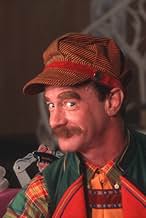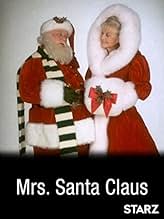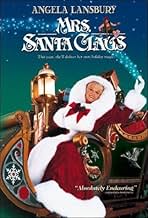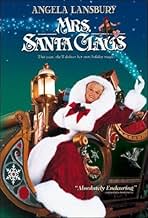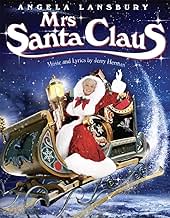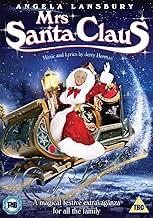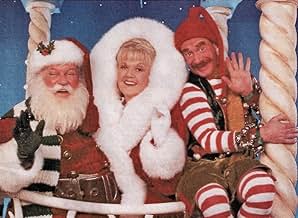Ajouter une intrigue dans votre langueNeglected by her husband during the pre-Christmas rush, Mrs. Claus takes the reindeer and sleigh out for a drive, only to end up stranded in the multicultural neighborhood of Manhattan's Low... Tout lireNeglected by her husband during the pre-Christmas rush, Mrs. Claus takes the reindeer and sleigh out for a drive, only to end up stranded in the multicultural neighborhood of Manhattan's Lower East Side of the early 1900s.Neglected by her husband during the pre-Christmas rush, Mrs. Claus takes the reindeer and sleigh out for a drive, only to end up stranded in the multicultural neighborhood of Manhattan's Lower East Side of the early 1900s.
- A remporté 1 prix Primetime Emmy
- 1 victoire et 7 nominations au total
- Marcello Damaroco
- (as David Noroña)
- Izzy
- (as Chachi Pittmann)
Histoire
Le saviez-vous
- AnecdotesEstablishing the 1910 to 1912 era was a major decision for the costuming, because Director Terry Hughes had also suggested the 1919 to 1920s to establish the period musical. The '20s meant the Flapper period in costuming. Costume Designer Bob Mackie determined the "teens" was a better period "skirt look" than the '20s shorter hemline, which would effect Dame Angela Lansbury's appearance, hair and wardrobe. Bob Mackie's Christmas green and red costume color palette dramatically determined the set's color range. Production Designer Hub Braden was confronted with the Universal Studios New York backlot exteriors' color condition. The previous movie company using the New York street had painted all of the exteriors in fresh coats of "city slicker contemporary" whites, grays, bright paint colors. New York City research for 1910 established "a look for" the New York City streets' building façades awash with a coal dust dirty patina. Specific building façades/exteriors chosen were repainted with variations of warm values either in muted rose or mistletoe green shades, alternating with beige and the color of "reindeer tan" shades. Iron fire escapes added to the exterior buildings for cast members to be elevated above the street level for the production value in the musical street choreographed marches and dancing patterns. Establishing a conglomeration of Irish, Italian, and Jewish neighborhood celebrating the holiday spirit, strings of bare bulbs were strung across the streets. With period street lamps, to justify a source light for all of the night filming. 1910 dictated horse drawn wagons, carts, and carriages instead of vintage motorized vehicles. The December snow required more selected areas for set dressing effects, which included watered down streets from melting snow... allowing planes of water pools reflecting for camera angles. Rehearsing the group marchers for the women's suffrage liberation issues were scheduled for morning activities, with summer morning temperatures near mid ninety to one hundred degrees. Progressive filming of the street sequences required much patience for cast, crowd and dance extras, animals, crew, and production personnel. Scheduling the day and night street filming became a critical lighting factor because of temperature, the sun and shadow path angles reflected for the point-of-view shooting direction for the multiple - main camera, for second, and third camera positions.
- GaffesMrs. Santa Claus says, "Oh, team, we've done it - 1910 is a record year." The U.S. was comprised of just 46 states in 1910. But in the suffrage parade, people are carrying an unfurled American flag that has 48 stars. New Mexico joined the Union in January 1912 and Arizona joined in February of that year.
- Citations
Mrs. Santa Claus: [takes Nora aside] I have to go now, sweetheart.
Nora Kilkenny: All right, I'll see you tomorrow.
Mrs. Santa Claus: Actually, I'm going back home.
Nora Kilkenny: But you can't go! Not yet!
Mrs. Santa Claus: Someone back home really needs me. Now, don't worry, I haven't forgotten. I still have presents for you and the other kids.
Nora Kilkenny: Will I ever see you again?
Mrs. Santa Claus: Oh, I hope so. In the meantime, when you look up at the evening sky, and you see a star. You'll know who I'm thinking of.
[hugs Nora goodbye]
- ConnexionsFeatured in Biography: Angela Lansbury: A Balancing Act (1998)
- Bandes originalesPraise Mrs. Claus
Music and Lyric by Jerry Herman
Performed by Michael Jeter, Kristi Lynes, Jamie Torcellini, Angela Lansbury and company
Composer Jerry Herman was very ill with HIV at the time this was being filmed. She also did this as a favor to him. He really wanted her to do the TV movie of MAME, saying that she was still able to pull it off, but she felt she was too old for the role, and so to do something for her friend, she did this musical, and I am glad she did this (although MAME would have been awesome, and finally a good movie).
The score, orchestrations are 10 out of 10, the only problem I had was with a few of the special effects, I felt they could have been a notch better.
Lansbury and Durning are excellent. This is a great 2 hour experience of the kind of movie that is so rare, and it works because of all of the broadway talent involved, that's who should be making musicals. Director Rob Marshall (Chicago) did the choreography and that's superb.
Great movie, great cast, great music! The DVD also has a great but short "making of." on it, the DVD is definitely in my collection! I wish some of Herman's other shows were good movies, Hello Dolly being the only good one, my opinion of course. There's The Grand Tour, Dear World, La Cage Aux Folles, Milk and Honey and Mack and Mabel, great musicals without being filmed.
- mntwister
- 16 juill. 2004
- Lien permanent
Meilleurs choix
Détails
- Date de sortie
- Pays d’origine
- Langue
- Aussi connu sous le nom de
- Maman Noël
- Lieux de tournage
- Hayvenhurst Studios - 7017 Hayvenhurst Avenue, Van Nuys, Los Angeles, Californie, États-Unis(solid special effects studio)
- sociétés de production
- Consultez plus de crédits d'entreprise sur IMDbPro
- Durée1 heure 30 minutes
- Couleur
- Rapport de forme
- 1.33 : 1
Contribuer à cette page



